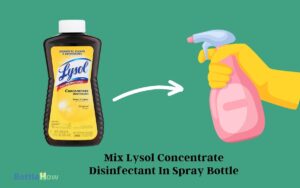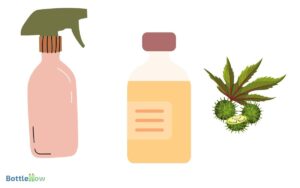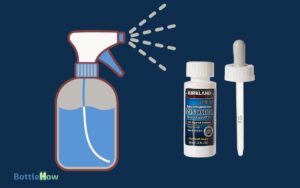Can You Put Roundup in a Spray Bottle? Yes!
Yes, you can put Roundup in a spray bottle, but you’ll need to follow precise dilution instructions to maintain safety and efficacy.
First, confirm whether you’re using a ready-to-use formulation or a concentrate. If it’s a concentrate, carefully measure and mix the solution according to the label’s specified ratio for your specific weed problem.
Always use protective gear, including gloves and goggles, during both mixing and application processes. Additionally, guarantee uniform coverage while spraying to effectively target all intended weeds.
Proper application extends beyond just mixing; understanding these techniques optimizes results and minimizes risks, providing more insights on achieving the best outcomes.

Key Takeaways
Understanding Roundup Formulations
Roundup, a widely used herbicide, is available in various formulations, each designed for specific applications and environments.
You’ll find that the choice of formulation is essential to achieving effective weed control without causing unintended harm to desirable plants or soil health.
For instance, Roundup‘s ready-to-use (RTU) formulations are diluted to specific concentrations, making them suitable for direct application in residential settings.
Conversely, their concentrated products require precise dilution, tailored to the intensity of weed infestation and the type of vegetation being targeted.
Understanding the active ingredients, primarily glyphosate, and their interaction with plant physiology helps in selecting the appropriate product.
Always check the product label for recommended usage rates and compatible spray equipment to ensure ideal application and results.
Safety Considerations for Spraying
While selecting the right Roundup formulation is important for effective weed control, it’s equally essential to focus on the safety practices involved in its application. As you prepare to use Roundup, following stringent safety measures not only protects you but also those around you.
Here are key safety considerations:
- Wear Protective Gear: Always use gloves, goggles, and long-sleeved clothing.
- Ventilation: Spray in well-ventilated areas to avoid inhaling fumes.
- Avoid Skin Contact: Make sure that the herbicide doesn’t come into contact with your skin.
- Proper Storage: Keep the product away from children and pets, stored in a secure location.
Preparing Roundup for Use
To prepare Roundup for application, you’ll need to dilute the concentrate with water according to the manufacturer’s instructions.
- First, identify the correct ratio of concentrate to water; this varies based on the specific Roundup product and the type of weeds you aim to control.
- Typically, this ratio is prominently displayed on the product label and must be followed precisely to guarantee effectiveness and safety.
- Next, use a clean, dedicated measuring cup to pour the concentrate into the spray bottle. Add the corresponding amount of water to achieve the necessary concentration.
- It’s essential to mix the solution thoroughly by shaking or stirring, ensuring the concentrate is completely dissolved. This step guarantees that the active ingredients are evenly distributed throughout the solution.
Application Techniques
You’ll achieve the best results by applying Roundup early in the morning or late in the afternoon when the wind is calm and the weather is cool. This timing minimizes evaporation and maximizes the herbicide’s effectiveness.
For ideal application, consider these technical steps:
- Uniform Coverage: Guarantee the spray is evenly distributed over the weeds to avoid missed spots and potential regrowth.
- Distance and Pressure: Maintain a consistent distance and pressure while spraying to deliver the herbicide effectively.
- Avoid Drift: Use a low-pressure setting to prevent spray drift that can harm nearby desirable plants.
- Follow Label Instructions: Adhere strictly to the concentration and application rates specified on the Roundup label to ensure safety and effectiveness.
Cleaning and Storage Tips
After applying Roundup with the proper techniques, it’s crucial to clean and store your equipment correctly to maintain its condition and efficacy.
Immediately after use, thoroughly rinse the spray bottle with water to remove any residual herbicide, which can degrade the material of the bottle over time. After rinsing, fill the bottle with clean water and spray a few times to ensure that the nozzle is completely clear of any remaining residue. This step is especially important if you plan to reuse the bottle for other liquids, such as perfume oil in a spray bottle, to prevent cross-contamination. Proper cleaning and drying will help maintain the integrity of the bottle and ensure it remains safe for future use.
Use a neutralizing agent, like diluted ammonia or bleach, to wash the bottle, guaranteeing that no active ingredient remains that could harm non-target plants in future applications. Allow it to air dry completely before sealing and storing.
Store the bottle in a cool, dry place, away from direct sunlight and extreme temperatures, which can alter the chemical composition of stored herbicides. Proper maintenance guarantees safety and effectiveness in your ongoing care and stewardship activities.
Conclusion
As you wrap up your Roundup application, remember that ‘a stitch in time saves nine.’ Confirm you’ve thoroughly cleaned your spray bottle to prevent residue buildup and malfunctions.
Store both the sprayer and chemical in a cool, dry place, avoiding direct sunlight and extreme temperatures to maintain efficacy.
By adhering to these precise practices, you’ll maximize safety and effectiveness, guaranteeing your efforts in weed control are both efficient and sustainable.






